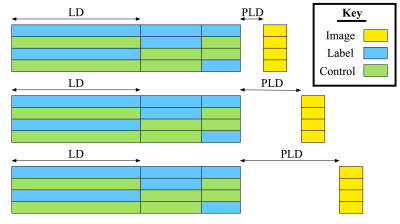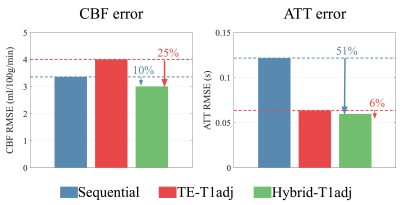2161
A novel hybrid of time-encoded and sequential multi-PLD PCASL for improved cerebral blood flow estimation1Wellcome Centre for Integrative Neuroimaging, FMRIB, Nuffield Department of Clinical Neurosciences, University of Oxford, Oxford, United Kingdom, 2Institute of Biomedical Engineering, University of Oxford, Oxford, United Kingdom
Synopsis
We present a novel hybrid combination of time-encoded and sequential multi-PLD pseudo-continuous ASL, which benefits from the advantages of both techniques, and demonstrate that the increased flexibility of this approach improves CBF precision compared to either method alone.
Introduction
Time-encoded (TE) pseudo-continuous Arterial Spin Labeling (PCASL)1 splits the ASL preparation into a series of blocks which are switched between label and control conditions across measurements according to a Hadamard encoding scheme. Perfusion images at different effective post-labeling delays (PLDs) are then decoded after image acquisition. TE is known to benefit ASL cerebral blood flow (CBF) measurements through improved noise averaging compared to a matched conventional sequential multi-PLD PCASL protocol2. However, the act of encoding the ASL signal in blocks to obtain temporal information limits the use of long PCASL label durations (LD) in practice, reducing the strength of the accumulated ASL signal. As a result, a recent PCASL comparison study3 found that sequential multi-PLD PCASL had more reproducible CBF estimates. However, TE PCASL had more reproducible arterial transit time (ATT) estimates, due to its ability to better sample the signal from inflowing labeled blood.
In this work, we present a novel hybrid combination of TE and sequential multi-PLD PCASL, which benefits from the advantages of both techniques, and demonstrate that the increased flexibility of this approach improves CBF precision compared to either method alone.
Methods
Two hybrid-TE methods were designed, combining 1) TE fixed-block1 and 2) TE T1-adjusted4 methods with sequential PLDs (hybrid-fixed and hybrid-T1adj respectively). Figure 1 shows an example schematic of the hybrid-T1adj method. The hybrid-TE methods were optimized and compared against optimized sequential multi-PLD5, TE fixed-block (TE-fixed) and TE T1-adjusted (TE-T1adj) protocols.
All methods were optimized for CBF measurements6, using the Cramér-Rao Lower Bound (CRLB) on the parameter covariance matrix, across an expected healthy ATT range of 500–1800ms, and a fixed scan time of 5 minutes. Sequential multi-PLD was optimized for multiple LD and PLD combinations. TE-fixed and TE-T1adj were optimized for total LD and final PLD. The hybrid methods were optimized for total LD, number of final PLDs and duration of final PLDs.
Monte Carlo (MC) simulations were used to validate the CRLB predicted variance and explore the benefits of each method. Data was generated and encoded appropriately for each protocol with realistic noise added. The noisy data was decoded for the TE protocols and fit using a variational Bayesian approach7.
Results
The optimized protocols are shown in Table 1. Long LDs and PLDs were found to be optimal for sequential multi-PLD. 7 TE-blocks were chosen for both TE-fixed and TE-T1adj. The hybrid-TE methods both had 3 TE-blocks and 5 PLDs. For the TE protocols, TE-T1adj had lower CBF and ATT errors than TE-fixed, while for the hybrid-TE methods, hybrid-T1adj had lower CBF and ATT errors than hybrid-fixed. Therefore, TE-T1adj and hybrid-T1adj are used in further analysis, for clarity.
The predicted standard deviation and the MC simulation root-mean-squared-error (RMSE), for sequential multi-PLD, TE-T1adj and hybrid-T1adj, are shown in Figure 2. There is good agreement between predicted and simulated errors, confirming the predicted errors. Hybrid-T1adj maintained the lowest CBF and ATT error across almost all of the ATT distribution.
The MC simulation mean errors are shown in figure 3. Hybrid-T1adj reduced CBF errors by 10% and 25%, and ATT errors by 51% and 6% compared to sequential mutli-PLD and TE-T1adj, respectively.
Discussion
We found that when TE-PCASL was combined with multiple different PLDs, it can outperform both sequential and standard TE methods for CBF estimation, while retaining excellent ATT precision. This is likely because the hybrid methods benefit from using a small number of TE blocks with relatively long LDs: in conventional TE-PCASL this would result in poor temporal resolution, but this is recovered through the different sequential PLDs.
Compared to conventional sequential PCASL, the hybrid methods benefit from the improved noise averaging and ATT estimation that arise from the TE approach. Both methods also chose 5 sequential PLDs, suggesting that the reduction in averages for each effective PLD is outweighed by the extra information gained from the sequential PLDs.
Future work will include a thorough in vivo comparison to validate these results.
Acknowledgements
This work was supported by funding from the Engineering and Physical Sciences Research Council (EPSRC) and Medical Research Council (MRC) [grant number EP/L016052/1]. The Wellcome Centre for Integrative Neuroimaging is supported by core funding from the Wellcome Trust (203139/Z/16/Z).References
- Günther M. Highly efficient accelerated acquisition of perfusion inflow series by Cycled Arterial Spin Labeling. Proc Intl Soc Mag Reson Med 2007; 15: 2007.
- Dai W, Shankaranarayanan A, Alsop DC. Volumetric measurement of perfusion and arterial transit delay using hadamard encoded continuous arterial spin labeling. Magn Reson Med 2013; 69: 1014–1022.
- Guo J, Holdsworth SJ, Fan AP, Lebel MR, Zun Z, Shankaranarayanan A et al. Comparing accuracy and reproducibility of sequential and Hadamard-encoded multidelay pseudocontinuous arterial spin labeling for measuring cerebral blood flow and arterial transit time in healthy subjects: A simulation and in vivo study. J Magn Reson Imaging 2017; : 1–14.
- Teeuwisse WM, Schmid S, Ghariq E, Veer IM, Van Osch MJP. Time-encoded pseudocontinuous arterial spin labeling: Basic properties and timing strategies for human applications. Magn Reson Med 2014; 72: 1712–1722.
- Wang DJJ, Alger JR, Qiao JX, Gunther M, Pope WB, Saver JL et al. Multi-delay multi-parametric arterial spin-labeled perfusion MRI in acute ischemic stroke - Comparison with dynamic susceptibility contrast enhanced perfusion imaging. NeuroImage Clin 2013; 3: 1–7.
- Woods JG, Chappell MA, Okell TW. Optimizing Post Labeling Delays in Multiple-Delay Arterial Spin Labeling MRI for Cerebral Perfusion Imaging. Magn Reson Mater Phy 2017; 30: 233-234.
- Chappell MA, Groves AR, Whitcher B, Woolrich MW. Variational Bayesian Inference for a Nonlinear Forward Model. IEEE Trans Signal Process 2009; 57: 223–236.
Figures



